Moose Management: Sustainable Strategies for Balance
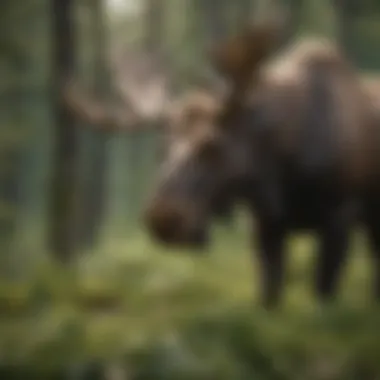
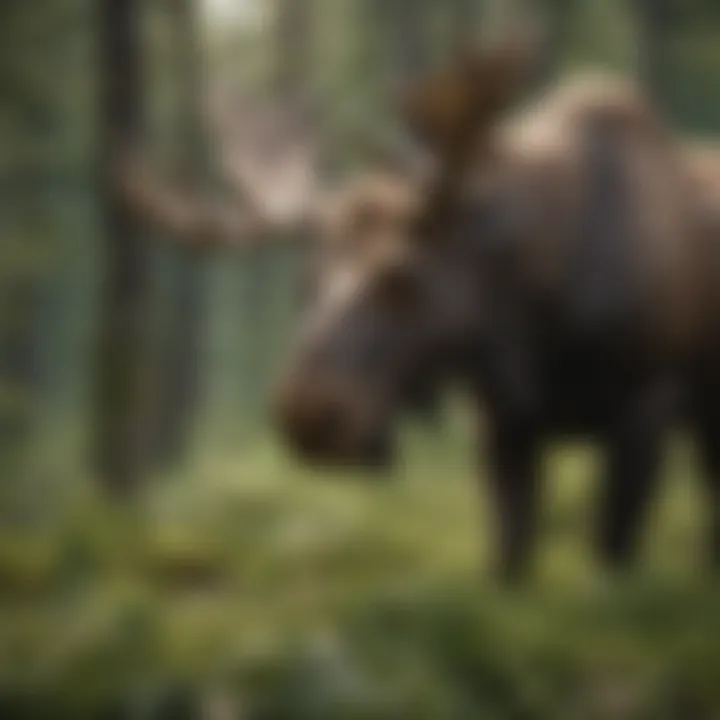
Overview of the Topic
Moose are intriguing creatures that hold a special place in the ecosystems they inhabit. They play a pivotal role in their environments, contributing significantly to the ecological balance. However, their populations can swing wildly, leading to both over-abundance and scarcity. Understanding moose management is essential, particularly regarding strategies for sustainable population control and habitat preservation. Both conservationists and local communities have to grapple with issues surrounding the management of moose populations to ensure their survival and the health of surrounding ecosystems.
Population fluctuations are natural, but when they occur at extreme rates, they can cause significant problems. This article aims to provide insights into effective management techniques, highlighting the importance of maintaining a balance between human activities and moose populations.
Current Status and Challenges
Currently, the moose population across North America is diverse, with estimates suggesting there are about 1 million moose in the wild. While some regions witness thriving populations, others suffer from decline due to habitat loss, climate change, and increased predation.
Challenges Facing Moose Populations:
- Habitat Encroachment: Urban development and logging activities have shrunk moose habitats, reducing their food sources and safe spaces to roam.
- Climate Change: Changes in weather patterns impact the vegetation that moose rely on for sustenance.
- Predation and Hunting: Encounters with natural predators and human hunting pressure create additional challenges for moose survival.
- Disease: Outbreaks of diseases like Chronic Wasting Disease can reduce numbers and weaken populations.
These factors don’t just threaten the moose themselves but also the broader ecological network they are part of. The complexity of these challenges requires holistic solutions and strategies.
Sustainable Solutions
Addressing the challenges surrounding moose management demands innovative practices and concerted efforts among various stakeholders. These include local communities, government bodies, and conservation organizations.
Effective Strategies:
- Restricting Habitat Development: Urban planners and developers must prioritize wildlife corridors to facilitate moose movement and aid habitat connectivity.
- Public Education: Engaging local populations and educating them about the ecological role of moose helps reduce human-wildlife conflicts.
- Targeted Hunting Regulations: Implementing specific hunting quotas allows for population control while maintaining healthy numbers.
- Monitoring and Research: Continuous scientific research plays a vital role in understanding moose behavior and the status of populations.
"Collaborative approaches are key to sustainable moose management, involving not just ecological considerations but also social dynamics."
Various case studies illustrate the success of implementing these strategies. For instance, in the northeastern U.S., certain regions have implemented protective measures to shield sensitive habitats, which has shown promising results in retaining healthy moose populations.
Impact and Importance
The ecological ramifications of moose management extend beyond just the species itself. Moose are considered a keystone species, meaning their presence and behavior influence many other organisms within the ecosystem.
- Nutrient Cycling: Their grazing habits help shape plant communities, allowing sunlight to reach the forest undergrowth.
- Biodiversity: The presence of moose can support a diverse range of plant and animal life that depend on their habitats.
Fostering moose populations can also bolster local economies through eco-tourism. At the same time, all efforts to control and nurture moose populations will have long-term repercussions for future generations.
Ultimately, recognizing the delicate balance in natural ecosystems and advocating for the sustainable use of resources are foundational for effective moose management. By focusing on thoughtful conservation strategies, we can protect not only moose populations but also the entire fabric of their habitats.
Foreword to Moose Management
Managing moose populations isn't just about keeping numbers in check; it's a holistic endeavor that balances ecological integrity with human activities. The complexities surrounding moose management come from recognizing the critical role these animals play within their ecosystems and the challenges they face due to shifting landscapes, climate variations, and human interference. To tackle these nuances, this article delves into various facets of moose management, highlighting methods that promote sustainable practices while ensuring that habitats remain intact for future generations.
Importance of Moose in Ecosystems
Moose are often seen as a symbol of wilderness in many regions, particularly across Canada and parts of the northern United States. Their significance stretches beyond mere aesthetics. As large herbivores, moose influence vegetation patterns, creating opportunities for a diverse array of plant species to thrive. This interaction not only shapes the landscape but also creates habitats favorable for numerous other wildlife species. For instance, by browsing on certain tree species, moose enable the understory to flourish, thus providing cover and food for birds and smaller mammals.
- Large populations of moose can impact forest composition profoundly, especially in regions with rich biodiversity.
- Their grazing habits foster a balanced ecosystem and contribute to maintaining the health of the biomass.
Moreover, moose are part of the food web, playing a crucial role in supporting predators like wolves and bears. Understanding their significance can guide effective management strategies that embrace the intricacies of ecosystem interactions.
Historical Context of Moose Management
The management of moose has evolved significantly over the decades. In the early days, unmanaged hunting led to dramatic population fluctuations and, in some areas, drastic declines. Historical overharvesting, spurred by market hunting in the late 19th and early 20th centuries, raised alarms among conservationists and prompted protective measures.
The 20th century saw a shift towards regulated hunting practices, including licensing and seasons, allowing populations to stabilize. As populations rebounded, the focus shifted toward a more comprehensive understanding of ecological balance, recognizing that just controlling the numbers isn't enough.
From the early conservation efforts to the contemporary approaches that utilize technology and scientific research, the history of moose management reflects a learning curve. It's a story of adapting to environmental changes and societal values that emphasizes the need for sustainable practices.
"Management strategies must reflect both the ecological needs of moose and the realities of human expansion into their habitats."
In summary, the history of moose management illustrates a progression from exploitation to a more nuanced appreciation of ecological interdependence. It highlights the importance of recognizing both the natural world and human demands to navigate the future of moose populations effectively.
Key Principles of Moose Management
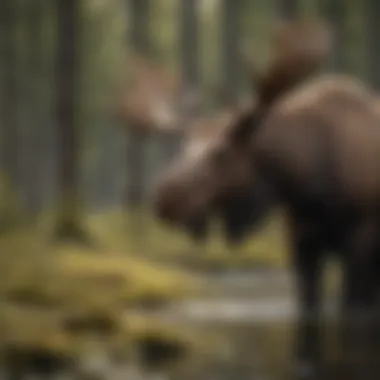
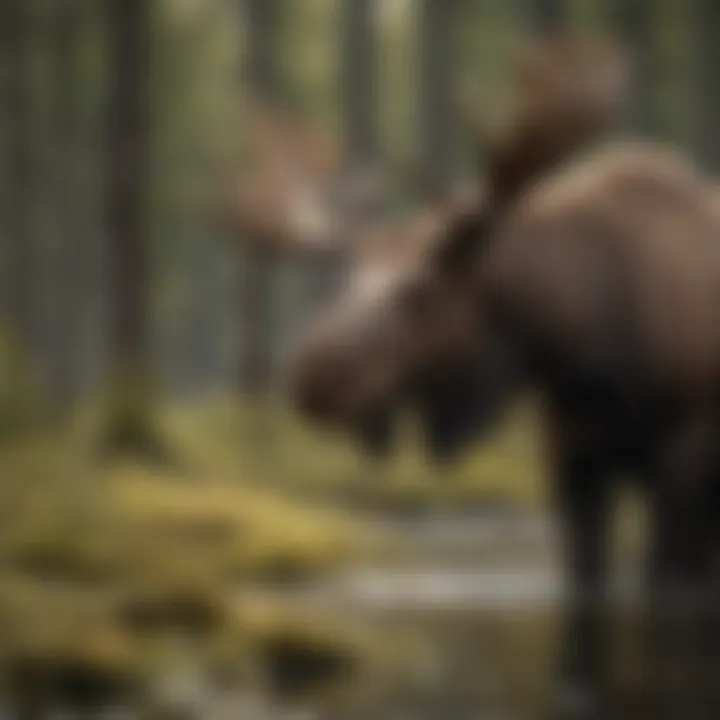
Moose management is not solely about numbers; it requires a sharp understanding of various principles guiding sustainable practices. Key principles serve as the backbone for effective strategies that enhance both the health of moose populations and their habitats. With the growing pressures of human activity and environmental shifts, recognizing these principles becomes vital for crafting informed management policies.
A thorough grasp of these principles ensures that moose populations thrive while mitigating human-wildlife conflicts. These principles take into account biological factors like population dynamics and habitat needs, as well as sociopolitical elements such as community involvement and regulations. Striking a balance among all of these facets paves the way for sustainable practices that not only benefit wildlife but also foster healthy interactions with human communities.
Population Dynamics and Growth Rates
Understanding population dynamics is crucial in moose management. Moose populations are influenced by various factors such as birth rates, death rates, and the carrying capacity of their habitats. When we take a closer look, we see that these populations typically experience cyclical trends. For example, a sudden increase in food availability—perhaps due to a reduction in predation or favorable weather conditions—can lead to rapid growth. Conversely, harsh winters or diseases can decimate numbers in a heartbeat.
Considering these growth rates helps managers implement timely interventions to maintain balance. If numbers spiral out of control, habitats face degradation due to overgrazing, while too few moose can disturb the ecosystem's functioning. The key is adaptive management, where continuous monitoring allows for adjustments in hunting regulations or habitat restoration efforts.
For instance, studies show that in areas like Alaska, moose populations have rebounded from near extinction in the early 1900s to stable, healthy numbers today, thanks to diligent management efforts that account for these growth dynamics.
Habitat Requirements and Preferences
Moose are selective grazers, relying heavily on specific vegetation types prevalent in their habitats. Understanding these requirements and preferences is fundamental to effective moose management. Their diets primarily consist of aquatic plants, shrubs, and tree buds, predominantly from species like willow and birch. Hence, these factors dictate their range and habitat choices.
Moreover, the structure of the habitat plays a significant role in their comfort and survival. Moose prefer dense cover but also need open spaces to forage. Thus, fragmentation of their habitats—often a result of urban development or logging—can pose challenges. When habitats fragment, moose may struggle to find adequate food, leading to nutritional stress and lowered reproductive success.
An ideal habitat will provide a diverse mix of feeding and nesting areas, promoting population health and biodiversity.
To ensure that moose continue to flourish, habitat management strategies must include:
- Preserving wetlands and riparian zones: These areas are rich in aquatic plants that moose favor.
- Mitigating land-use conflicts: Engaging local communities to minimize disturbances during peak moose activity times.
- Restoring native vegetation: Planting and encouraging species that moose rely on to maintain natural feeding patterns.
In summary, recognizing and incorporating population dynamics as well as habitat preferences into management practices is not just beneficial but essential. By adapting these principles into a cohesive strategy, stakeholders can ensure sustainable moose population management that is both ecologically sound and socially responsible.
Strategies for Population Control
Population control is a cornerstone of effective moose management, balancing the needs of the ecosystem with those of human communities. When moose populations are too high, they can lead to a myriad of problems, including overgrazing, increased vehicle collisions, and strain on local agriculture. Therefore, understanding and implementing strategies for population control is critical in maintaining ecological equilibrium and enhancing human-wildlife coexistence.
Hunting Regulations and Licenses
Hunting regulations and licensing are fundamental tools in the population control arsenal. These regulations are more than just rules; they delineate which species can be hunted, during what seasons, and how many animals hunters can take. This structured approach ensures that moose populations do not dwindle to unsustainable levels or become overpopulated, which could lead to health issues in the herd and damage to their habitat.
In many regions, local agencies set quotas based on ecological assessments, season surveys, and biological studies, aiming to keep the population within a threshold that is sustainable. By enforcing licensing, authorities can track who is hunting and how many animals are harvested, creating a data-driven approach to conservation that benefits everyone involved. For instance, in places like Alaska and Canada, hunters often need to acquire specific tags that correspond to certain hunting zones, contributing to targeted population management.
Engagement with local communities is also vital. Hunters often have a deep understanding of the land and animals, which makes their insight invaluable in formulating effective management strategies. The collaboration between wildlife authorities and hunters can result in more responsible practices, ultimately benefiting moose populations and human interests alike.
Sterilization and Relocation Programs
While hunting is a traditional method of managing moose numbers, sterilization and relocation programs present an innovative alternative. These non-lethal strategies aim to reduce populations without the ethical concerns often associated with hunting.
Sterilization involves medical procedures to prevent reproduction in certain moose populations. This strategy has the potential to stabilize populations without dramatically decreasing numbers, making it a humane option. Researching and developing effective sterilization techniques is ongoing, but initial results have shown promise in urban areas or regions where hunting might not be feasible due to public sentiment.
Similarly, relocation involves capturing moose and transporting them to less populated areas where resources are abundant, and competition is reduced. This requires a delicate touch — moving moose can be stressful for the animals and needs to be done during times when they are less likely to be disrupted. Effective relocation must also consider the habitat in the destination area to ensure that it can support the introduced moose without leading to conflicts with local wildlife or agricultural concerns.
Both of these strategies highlight the importance of developing tailored management approaches. Each local ecosystem is different, and what works in one region might not apply in another. Therefore, having customized management plans that account for local ecology, human influence, and animal behavior is essential.
"Sustainable management of moose populations requires constant adaptation to changing environmental factors and human needs."
Utilizing a blend of hunting regulations, sterilization, and relocation programs can create a more nuanced approach, ensuring healthier moose populations and more robust habitats. This integrated management can help maintain the delicate balance of ecosystems and assure that human activities and wildlife coexist without conflicts.
Ecological Role of Moose
The ecological role of moose is pivotal in understanding the fabric of forest ecosystems where they reside. These large herbivores not only contribute to the biodiversity of their habitats but also shape it in ways that are crucial for various other species. The relationship between moose and their environment is substantial, influencing vegetation patterns, soil health, and the overall dynamics of the ecosystem.
Moose as a Keystone Species
Moose are often classified as a keystone species due to their profound impact on the ecosystems they inhabit. They feed on a variety of vegetation including shrubs, aquatic plants, and tree saplings. In doing so, moose help manage plant populations, ensuring no single species overgrows and outcompetes others. This browsing behavior is critical in maintaining the health of these communities. For instance, in areas where moose populations are abundant, the presence of young trees can decline, which in turn affects other wildlife that rely on those trees for nesting or food.
The relationship goes both ways; various plants have adapted to this browsing. Certain species have developed mechanisms to thrive, despite being consumed, either by growing tougher leaves or by increasing their reproduction rates. This continual interaction creates a balance that forms the backbone of forest health.
Impact on Vegetation and Biodiversity


The foraging habits of moose have substantial effects on both vegetation and biodiversity. As they navigate through forests and wetlands, they not only consume vast amounts of plant material, but they also prune certain species, allowing sunlight and resources to be shared amongst others. This presents a symbiotic situation where some plants can flourish while others are kept in check, allowing for a diverse plant community to exist.
Moose have been found to particularly favor species like willow, birch, and aspen, which can lead to identifiable patches of vegetation that support other wildlife. Birds, in particular, thrive in these newly nourished areas, leading to an increase in avian populations as fruits and seeds become more widespread. The relationship blurs as many other animals depend on the same vegetation, creating a network of dependency.
Moreover, the acts of foraging and trampling often help to aerate the soil, enriching it with nutrients and increasing its capacity to support other forms of life. This, in turn, prompts a healthy cycle of growth for both flora and fauna, ensuring that ecosystems remain robust and diverse.
"Moose are not just about the numbers; their impact transcends their size, weaving through the fabric of their habitats, supporting life in numerous forms.”
In summary, understanding the ecological role of moose is fundamental to grasping the complexities of forest dynamics. Their interaction with vegetation and other species presents an intricate web of life that highlights the importance of managing moose populations wisely. Keeping a balance is not merely about numbers but about preserving a legacy of biodiversity for future generations.
Challenges in Moose Management
The management of moose populations encounters a variety of obstacles that can hinder effective strategies for population control and habitat preservation. Understanding these challenges is crucial for developing robust management frameworks that accommodate the dynamic interplay between moose and their environments. This section delves into two major challenges: the impact of climate change and human-wildlife conflicts, both of which have significant implications on the moose management landscape.
Climate Change and Its Effects
Climate change poses a severe threat to moose populations and their habitats. As temperatures rise, so do the risks related to habitat degradation, changing food availability, and increased disease transmission. Moose are highly sensitive to heat, and with the traditional cold environments they thrive in becoming warmer, their health can suffer. This can lead to a decline in their population and overall ecosystem balance.
Moose rely on specific vegetation for nourishment. As climate shifts these habitats, moose may find it increasingly difficult to access the plants they need. Changes in plant phenology, including flowering times and nutritional quality, lead to lessened forage availability. Additionally, as the snowpack decreases in some regions, their natural predator-prey dynamics shift, potentially increasing their vulnerability to hunters and predators.
"Moose populations are not just affected by what is happening within their immediate environment, but also by global climate patterns that dictate the ecosystem's health."
Moreover, the increase in ticks due to milder winters can lead to severe health issues for moose. Infestations can cause anemia, and in severe cases, lead to death. This aspect directly ties climate change with population health, making it a key concern for wildlife managers.
Human-Wildlife Conflicts
As human populations expand into areas traditionally inhabited by moose, conflicts often arise. These conflicts can take many forms, including vehicle collisions, property damage, and competition for space. Such encounters can be dangerous for both humans and moose.
The rise in urban areas near wilderness regions has made it common for moose to venture into residential areas, seeking food or safety. This brings them into conflict with town residents, who may view them as pests rather than a vital part of the ecosystem. This perception can lead to calls for lethal control measures, which can halt sustainable management efforts.
Management practices must find a balance between conserving moose populations and addressing the valid concerns of communities affected by them. Engaging local communities is essential. Community-led educational initiatives can help increase awareness about moose behavior and the ecological importance of these creatures, potentially reducing fear and conflict.
In summary, challenges such as climate change and human-wildlife conflict necessitate thoughtful approaches in moose management. Any effective management plan must account for these complexities, balancing ecological integrity with the realities faced by human communities.
Stakeholder Involvement in Moose Management
When we think about moose management, it’s easy to focus only on the scientific measures or the regulatory aspects. But there’s a more intricate dance taking place behind the scenes—one that involves various stakeholders. Understanding the role of these stakeholders is crucial for both effective moose management and fostering sustainable ecological practices.
In essence, stakeholder involvement ensures that diverse perspectives are considered in the planning and decision-making processes. This approach not only leads to more balanced outcomes but also enhances public support for moose management initiatives.
Role of Government Agencies
Government agencies play a pivotal role in managing moose populations and their habitats. At the federal, state, and local levels, these organizations are tasked with creating policies, implementing management practices, and overseeing compliance with regulations. They are also responsible for conducting research and gathering data on moose populations which informs their strategic decisions.
Some key functions that these agencies fulfill include:
- Regulatory Framework: Establishing hunting licenses, quotas, and protected areas.
- Research Initiatives: Commissioning studies that shed light on population dynamics, health, and habitat needs.
- Conflict Resolution: Addressing issues arising from human-wildlife interactions, particularly in suburban areas where moose may wander.
The decisions made by government agencies have far-reaching impacts not only on moose populations but also on the ecosystem and human communities. An effective agency is one that collaborates with both experts and the public, fostering a sense of shared responsibility in managing wildlife.
Community Engagement and Education
Communities are often on the frontline of moose management, experiencing firsthand the realities of living in proximity to these magnificent creatures. Engaging with communities allows for the exchange of knowledge and fosters an environment where local practices are aligned with scientifically-informed strategies.
Community involvement has several benefits:
- Local Knowledge: Residents often have invaluable insights into moose behavior, migration patterns, and habitat changes.
- Support for Initiatives: When communities are educated and involved, they are more likely to support management strategies, whether it be hunting regulations or conservation efforts.
- Mitigation of Conflicts: Programs aimed at educating the public can significantly reduce the number of human-wildlife conflicts. For instance, educating residents about safe practices when encountering moose can prevent accidents.
"Public involvement transforms the management narrative from 'we know best' to 'let’s collaborate for the benefit of all.'"
In summary, both government agencies and community members are vital threads in the tapestry of effective moose management. By weaving together scientific research with local insights, management strategies can be more adaptable, sustainable, and ultimately successful.
Innovative Management Practices
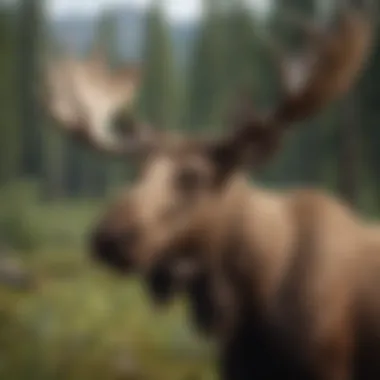

Innovative management practices play a crucial role in ensuring the sustainable control of moose populations while preserving their habitats. These methods go beyond traditional techniques, integrating modern technology and localized strategies tailored for specific ecosystems. By adopting innovative approaches, managers can address the intricacies of moose behavior and environmental needs more effectively. This not only benefits moose populations but also aligns management goals with ecological health and community interests.
Use of Technology in Monitoring Populations
The integration of technology in monitoring moose populations has revolutionized conservation efforts. Remote sensing tools, camera traps, and GPS tracking allow for real-time data collection, providing insights into moose movement patterns, population dynamics, and habitat use. These technologies enhance data accuracy and timeliness, allowing managers to make informed decisions quickly.
For instance, GPS collars provide essential data on moose migration and behavior during different seasons. This information helps identify critical habitats and potential areas of human-wildlife conflict. Furthermore, satellite imagery can help assess habitat conditions over large areas, identifying changes over time due to climate factors or land use changes.
Some specific benefits of technological monitoring include:
- Enhanced accuracy in population estimates.
- Ability to respond proactively to environmental changes.
- Improved understanding of moose interactions with their habitat.
"With advanced technology, we can track moose populations as they navigate changing landscapes, ensuring management practices are both timely and effective."
However, these methods come with considerations. Data privacy, cost implications, and the need for technical skills to interpret the data can pose challenges. As such, collaboration with tech experts and ongoing training for wildlife managers become essential components of this strategy.
Customized Management Plans Based on Local Ecology
Creating customized management plans that reflect local ecological realities is paramount in moose conservation. These tailored strategies consider the unique characteristics of a region, such as forest types, vegetation diversity, and local climate, which may influence moose populations differently.
One effective approach is involving local communities in the development of these plans. They possess valuable insights into the ecosystem's workings and moose behavior, contributing to a comprehensive understanding of how these animals interact within their habitats. Their participation fosters stewardship, ensuring that local values and knowledge shape management strategies.
Key factors to consider in developing customized management plans include:
- Habitat assessment: Understanding vegetation species composition and abundance.
- Human interaction: Addressing areas of conflict, like agricultural lands or urban interfaces.
- Ecological connectivity: Recognizing and maintaining corridors that facilitate moose movement across landscapes.
This localized focus enables stakeholders to devise strategies that not only support moose populations but also consider the broader ecological context. By working from the ground up, managers can enhance the effectiveness of their efforts in preserving both moose and their habitats for future generations.
Future Directions for Moose Management
As we look towards the future of moose management, it becomes increasingly important to consider strategies that not only focus on the immediate needs of moose populations but also embrace the long-term sustainability of their habitats and the ecosystems in which they exist. The convergence of ecological considerations with human activities presents a complex challenge. With the benefits of robust communication and collaboration among stakeholders, future efforts can lead to effective and respectful management practices.
One significant area of focus is the adaptive management approach. This method emphasizes the need for flexibility in management techniques. By observing and learning from both successes and failures in natural areas, managers can adjust their strategies over time. Not only does this promote resilience within moose populations, but it also allows for dynamic responses to changing environmental conditions, thereby safeguarding the intricate balance of their habitats.
Adaptive Management Approaches
Adaptive management involves a cycle of planning, monitoring, and adjusting based on the outcomes. This is a bit like figuring out a recipe: if one ingredient doesn’t taste quite right, a good cook will tweak it, perhaps adding more of this or less of that. In the same way, wildlife managers can analyze data regarding moose populations, hunting quotas, and habitat conditions and then refine their methods accordingly. The potential advantages of this approach are manifold:
- Responsive Strategies: It’s easier to react to changes in moose population dynamics or habitat degradation when management plans are rooted in ongoing observation.
- Informed Decision-Making: Real-time insights can lead to better decisions, ensuring practices are evidence-based rather than guesswork.
- Collaborative Learning: This approach fosters partnerships between scientists, wildlife organizations, and local communities, creating a collective knowledge base that benefits everyone involved.
One challenge of adaptive management is the need for reliable data. Without this, it’s difficult to evaluate the effectiveness of any changes made. So continuous data collection and analysis become paramount in driving successful management outcomes.
Integrating Conservation Efforts with Human Needs
The integration of conservation efforts with human needs has emerged as another vital direction for moose management. Recognizing that humans and wildlife often share the same spaces can lead to better coexistence. People living near moose habitats frequently have their own set of needs, from agricultural pursuits to land development. Therefore, finding common ground is essential.
A few particular elements to consider include:
- Education and Awareness: Informing local communities about the ecological role of moose can foster a sense of stewardship. For instance, programs aimed at schools can instill appreciation from a young age.
- Conflict Mitigation: Practical strategies should be put in place to reduce issues like wildlife collisions or property damage caused by moose foraging on crops. Simple solutions, such as physical barriers or compensation arrangements for lost crops, could be effective.
- Community Involvement: Engaging the public in decision-making processes leads to better management outcomes. When local communities are part of the conversation, they’re more likely to support and engage in management practices.
As we navigate future directions in moose management, it’s crucial to recognize that success isn’t solely about controlling populations—it’s about establishing a harmonious relationship between wildlife and the people affected by their presence. Collaborative efforts are essential, not only for the moose but for all aspects of our interconnected ecosystems.
Effective management of moose populations can only occur through understanding and integrating the needs of both wildlife and human communities.
Finales
In reflecting upon the multifaceted world of moose management, it becomes evident that an integrated approach is essential for ensuring the long-term sustainability of both moose populations and the habitats they inhabit. The balance between wildlife conservation and human necessity is delicate, yet crucial. The discussions throughout this article underscore several key elements that should be at the forefront of decision-making processes regarding moose management.
Summary of Key Points
The crux of effective moose management lies in understanding the intricate dynamics of ecological systems, human interactions, and regulatory frameworks. Below are some of the vital points that emerged in this discourse:
- Ecological Importance: Moose play a pivotal role in their ecosystems, influencing vegetation patterns and providing habitat for other species. Their presence affects biodiversity, making them a keystone species in their environments.
- Population Control Strategies: Implementing hunting regulations and exploring non-lethal intervention techniques like sterilization and relocation are fundamental in managing populations sustainably, allowing habitats to remain productive without overburdening resources.
- Stakeholder Involvement: The participation of local communities and governmental agencies fosters a diverse dialogue, ensuring that management practices align with both conservation goals and human needs.
- Challenges in Management: Factors such as climate change pose significant hurdles. By embracing adaptive management approaches, wildlife officials can respond dynamically to shifting conditions in the ecosystems moose inhabit.
- Future Directions: The integration of technological advancements, such as GPS tracking and automated monitoring systems, can provide real-time data that enhances management efforts and supports localized strategies.
Call for Collaborative Efforts in Management
The future of moose management hinges on collaboration across various sectors. As conservationists and stakeholders work together, pooling resources and knowledge, a more comprehensive approach emerges. This collaboration should aim to:
- Engage Educational Programs: Raising awareness about the ecological role of moose and the effects of their management on ecosystems would foster a sense of collective responsibility among communities.
- Develop Partnerships: Forming alliances between environmental groups, government bodies, and local populations will ensure that diverse perspectives are considered in crafting management strategies.
- Promote Research: Ongoing studies focusing on the impacts of climate shifts, habitat alterations, and population dynamics can lead to improved frameworks for moose management that are scientifically informed and adaptive.



